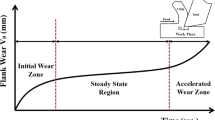Abstract
A wide variety of tool condition monitoring techniques has been introduced in recent years. Among them, tool force monitoring, tool vibration monitoring and tool acoustics emission monitoring are the three most common indirect tool condition monitoring techniques. Using multiple intelligent sensors, these techniques are able to monitor tool condition with varying degrees of success. This paper presents a novel approach for the estimation of tool wear using the reflectance of cutting chip surface and a back propagation neural network. It postulates that the condition of a tool can be determined using the surface finish and color of a cutting chip. A series of experiments has been carried out. The experimental data obtained was used to train the back propagation neural network. Subsequently, the trained neural network was used to perform tool wear prediction. Results show that the prediction is in good agreement with the flank wear measured experimentally.
Similar content being viewed by others
References
Bandyopadhyay, D. S. and Chattopadhyay, P. P. (1997) Neural-network-based tool wear monitoring in turning medium carbon steel using a coated carbide tool. Journal of Materials Process Technology, 63(1-3), 187-192.
Byrne, G., Dornfeld, D., Inasaki, I., Ketteler, G., Konig, W. and Teti, R. (1995) Tool condition monitoring?the status of research and industrial application. CIRP Annals, 44(2), 541-567.
Dan, L. and Mathew J. (1990) Tool wear and failure monitoring techniques for turning-A review. Int. J. Mach. Tools and Manufacture, 30(4), 579-598.
Javed, M. A., Hope, A. D., Littlefair, G., Adradi, D., Smith, G. T. and Rao, B. K. N. (1996) On-line tool condition monitoring using artificial neural networks, Insight, 38(5), May 1996.
Lippmann, R. P. (1987) An Introduction to computing with Neural Nets. Acoustics, Speech, and Signal Processing Magazine, 4(2), 4-22.
Rangwala, S. and Dornfeld, D. (1990) Sensor Integration Using Neural Networks for Intelligent Tool Condition Monitoring. Journal of Engineering for Industry, 112, 219-228.
Shi, T. and Ramalingam, S. Real-Time Flank wear sensing, Fundamental Issues in machining, American Society of Mechanical Engineers, Production Engineering Division (Publication) PED Published by ASME, New York, NY, USA, 43, 157-170.
Stockline, L. E. In process sensors, SME Technical Paper MS90-260; SME (1991).
Trent, E. M. Metal Cutting, Butterworth-Heinemann Ltd., U.K. (1991).
Author information
Authors and Affiliations
Rights and permissions
About this article
Cite this article
Yeo, S.H., Khoo, L.P. & Neo, S.S. Tool condition monitoring using reflectance of chip surface and neural network. Journal of Intelligent Manufacturing 11, 507–514 (2000). https://doi.org/10.1023/A:1026583821221
Issue Date:
DOI: https://doi.org/10.1023/A:1026583821221




